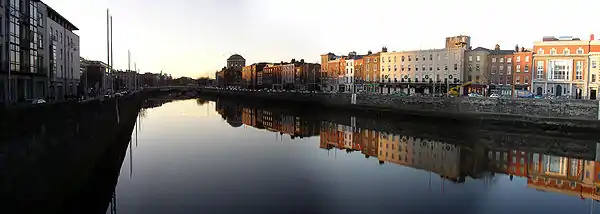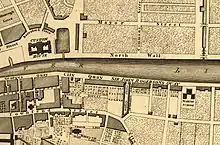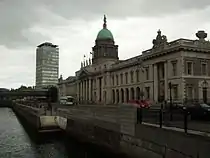Dublin quays
The Dublin quays (Irish: Céanna Bhaile Átha Cliath) refers to the two roadways and quays that run along the north and south banks of the River Liffey in Dublin, Ireland. The stretches of the two continuous streets have several different names. However, all but three of the names (Swift's Row, Bachelors Walk and Usher's Island) share the same "Quay" designation. The quays have played an important part in Dublin's history.[2]

Much of the southern roadway and about half of the northern roadway is part of the R148 road while the other half of the northern roadway is part of the R801 road.
Routes description

Both roadways run approximately 4.3 km (2.7 mi) from Sean Heuston Bridge in the west. The eastern end of the north roadway is at East-Link Bridge while the south roadway turns southward at the Grand Canal. Seventeen bridges cross the river along the line of The Quays; three of them are exclusively pedestrian bridges, one a railway bridge, one other for Luas trams (with another planned)[3] and pedestrians, and the remainder for vehicular and pedestrian use.
The name designations of the north roadway are (from west to east): Wolfe Tone Quay, Sarsfield Quay, Ellis Quay, Arran Quay, Inns Quay, Upper Ormond Quay, Lower Ormond Quay, Bachelors Walk, Eden Quay, Custom House Quay and North Wall Quay.
The name designations of the south roadway are (from west to east): Victoria Quay,[4] Usher's Island, Usher's Quay, Merchant's Quay, Wood Quay, Essex Quay, Wellington Quay, Crampton Quay, Aston Quay, Burgh Quay, George's Quay, City Quay, Sir John Rogerson's Quay and Britain Quay.
A majority of the roadways in the city centre are one-way with the north roadway being eastward and the south being westward.
History

Vikings were among the first settlers in Dublin and many Viking artifacts were found at what is now Wood Quay.[5] The quays were first developed during the time of King John in the early 13th century when the monarch licensed citizens to erect buildings on the River Liffey.[2] They became the centre of the Irish shipping trade until the 1800s when the river in this section was considered too shallow for the more modern heavy ships.

The Custom House, one of Dublin's major landmarks on Custom House Quay, was completed in 1791. The quay takes its namesake from the building. Later, the Four Courts on Inns Quay was completed in 1802 and is currently home to the Supreme Court of Ireland and the High Court. Both were designed by noted architect James Gandon.
Burgh Quay is named after Elizabeth Burgh, wife of Anthony Foster whose son was Rt. Hon. John Foster, last speaker of the Irish House of Commons. Burgh Quay was once the site of the Tivoli Theatre. The Corn Exchange Building, designed by George Halpin in 1815, was approved by the Wide Streets Commission in 1816 and work commenced on this building soon afterward. Its granite facade still remains on Burgh Quay. Shipping came as far upstream as Burgh Quay until 1879 when Butt Bridge was constructed. A number of the buildings on Burgh Quay (including number 8) still retain remnants of the shopfronts designed for the Wide Streets commissioners.
The 20th century saw much development to the quays. In 1845, McBirney, Collis & Company opened a store at 16 and 17 Aston Quay,[6] and remained on the site as a department store as McBirney's until 1984.[7] The building incorporated a set of three three-bay houses on the site, which was later remodelled in 1865. The building still retains an original store frontage of the department store.[6] The building was later occupied by a Virigin Megastore from 1986,[8] and is now a branch of the supermarket chain, SuperValu.[9][10] A controversial development was at Wood Quay by the Dublin Corporation in the late 1970s, when there were many archaeological Viking finds. This led to a very public and unsuccessful campaign to halt the development.[5] Announced in 1998 and with the first phase opened in late 2000,[11] the Liffey Boardwalk is a series of pedestrian walkways which were developed along the quays in the early 21st century.[12]
In 2006, local politicians proposed renaming some of the quays. MEP Gay Mitchell proposed renaming George's Quay or Victoria Quay to Joyce Quay or Behan Quay, for the Irish writers James Joyce and Brendan Behan.[13]
Dublin quays in culture
A number of artists have found inspiration from the quays. In 1898, author Frances A. Gerard described the Dublin quays as follows: "Much of the picturesque appearance of Dublin is due to the Quays which intersect the City and the Bridges which span the Liffey; they impart to it a foreign air resembling the Quays of Paris."[14] Irish novelist James Joyce had many of his story lines take place at the Dublin quays, including Eveline (1904) and An Encounter (1914). Joyce biographer Michael H. Begnal wrote, "Joyce associated the Liffey Quays with the desire for escape."[15]
Artist Jack Butler Yeats painted Dublin Quays in 1916.[16]
The 1987 film The Dead, adapted from Joyce's story, was filmed by John Huston at Usher's Island. In Joyce's story The Dead, the sisters Kate and Julia Morkan host their annual dance at their "dark gaunt house on Usher's Island." 'Ushers Island' was the name of a competitor in the 1994 Grand National at Aintree, falling at the third fence. In 2015, folk musician Andy Irvine launched a band called 'Usher's Island' (a reference to the Dublin quay), with members Dónal Lunny, Paddy Glackin, Michael McGoldrick, and John Doyle.[17]
Bachelors Walk was a comedy-drama aired on RTÉ during March 2001, following the lives of three bachelors who lived on the titular quay.
Rudyard Kipling began his poem "Belts" with the lines: "There was a row in Silver Street, that's near to Dublin Quay/Between an Irish regiment an' English cavalree."
Notable buildings on the Dublin quays
- The Custom House (Custom House Quay)
- Four Courts (Inns Quay)
- Central Bank of Ireland (North Wall Quay)
- Dublin City Council Civic Offices (Wood Quay)
- Liberty Hall (Eden Quay)
- Convention Centre Dublin (North Wall Quay)
- 3Arena (North Wall Quay), previously the Point Depot and the O2
- Church of the Immaculate Conception ("Adam and Eve's", Merchant's Quay)
- Clarence Hotel (Wellington Quay)
References
- Pears, Alexandria. The Quays Dublin. 2016.
- Gilbert, John Thomas (1854). A History of the City of Dublin. J. McGlashan. pp. 356. ISBN 0-14-303526-6.
- "Marlborough Street Public Transport Priority Bridge". Dublin City Council website. August 2011. Retrieved May 19, 2014.
- Christopher Moriarty – Exploring Dublin: Wildlife, Parks, Waterways – 2002 Page 44 "The outer face of the wall of Victoria Quay is something of a flower garden, even with an aspiration towards woodland. One little alder grows amongst the stonework and there are occasional sycamores. Red valerian, scentless mayweed, ..."
- Heffernan, Thomas Farel (1988). Wood Quay. University of Texas Press. ISBN 0-292-79042-2.
- "Super Valu, 14 - 17 Aston Quay, Bedford Row, Dublin 2, Dublin City". Buildings of Ireland. Retrieved 2020-12-03.
- White, Dan (2015-06-20). "Why out-of-date Clerys simply ran out of borrowed time". independent. Retrieved 2020-12-03.
- "Virgin Megastore Comes To Town 1986". RTÉ Archives. 1986-12-05. Retrieved 2020-12-03.
- Fagan, Jack (2014-12-03). "Former megastore bought for €9m". The Irish Times. Retrieved 2020-12-03.
- "The glamorous history of Dublin's lost department stores". RTÉ Lifestyle. 2020-09-07. Retrieved 2020-12-03.
- "Dublin's Liffey boardwalk: 'It could explode in a second'". irishtimes.com. Irish Times. 19 August 2017. Retrieved 15 November 2019.
- "2001 – Boardwalk, Liffey Quays, Dublin". Architecture of Dublin City. Archiseek. Retrieved 15 November 2019.
- Nolan, Larissa (May 14, 2006). "Name quays after Irish writers: Mitchell". Irish Independent.
- Gerard, Frances A. (1898). Picturesque Dublin: Old and New. New York City, New York: Hutchinson and Co. pp. 125–172.
- Begnal, Michael (1 June 2002). Joyce and the City: The Significance of Place. Syracuse University Press. pp. 19–20. ISBN 978-0815629429.
- Pyle, Hilary (1989). Jack B. Yeats, A Biography. Rowman & Littlefield. ISBN 0-389-20892-2.
- Celtic Connections: Usher's Island at Old Fruitmarket, Glasgow, heraldscotland.com, 28 January 2015; retrieved 18 March 2017.